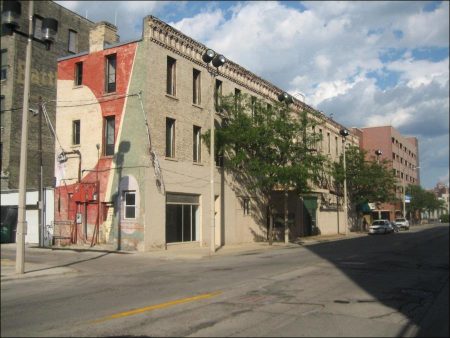Rockford (742. alt., 150,115 pop.), seat of Winnebago County and third largest city in Illinois, is bisected by the Rock River 18 miles south of the Wisconsin Line. The metropolitan area was home to 339,178 people as of the 2000 census. It was named for the shallow rockbottomed ford used by the Galena-Chicago stagecoach line before any settlement existed here.
Crowded by fine elms and oaks along the river banks with a background of extensive beds of colorful prairie flowers the ford presented a natural beauty that touched even the gruffest pioneer; one early traveler exclaimed enthusiastically, “I’ve lived in nineteen states and three territories and been whipped a thousand times, but I’m damned if I ever see so pretty a country as that.” Only one day’s journey from Chicago and Galena, the ford was unmistakably marked by geographic determinism as a city site. But when Galena declined and Chicago boomed, Rockford utilized its natural advantages of water power and fertile prairies to the full, and continued its growth unaffected.
Since the erection of the pioneer saw mill that buzzed with activity in the early days, the city’s industrial growth has been steady; the major industries of half a century ago–the manufacture of agricultural implements and furniture–rank among the first four today. Unblighted by mushrooming industrialism, Rockford has a pleasant informal appearance, heightened by rolling heavily wooded terrain, and scattered business districts, and a notable park system.
In designating their community “The Forest City,” Rockford’s citizens substantiated the phrase by a census that disclosed an average of 122 trees to a block. The city’s streets lend a further informality to the general scene, for they were laid out to humor the vagaries of the winding river, without heed of the future visitor who might have difficulty in finding his way.
As a result, tiny, variously shaped parks, formed as two or more streets veer suddenly to avoid others, appear in unexpected places; street numbers frequently have no continuity; wide boulevards narrow surprisingly and dead-end against a wall or group of buildings. Self-contained, Rockford has developed but one purely residential suburb, and has kept its finest estates within the city limits along with its manufacturing plants.
Rockford’s self-sufficiency appears also in its cultural activities, especially music. Although only two hours from Chicago, Rockford maintains a seventy-piece symphony orchestra and a supporting choral group. The Mendelssohn Club sponsors a concert series that has presented such singers as Lawrence Tibbett, Helen Jepson, and Nelson Eddy. The Svea Soner Society and Lyran Society, Swedish organizations, have their own halls and have toured the country in recitals.
Early settlement of the community was centered in the area now known as South Rockford, but as the chief residential section moved northward this neighborhood was left isolated by the intervening industrial district. For some time it was occupied by the Irish, but in the early 1900’s they too moved northward, and South Rockford was taken over by the Italians, who occupy it today, preserving a closely knit racial integrity.
Founded in 1834 by Germanicus Kent and Thatcher Blake of Galena, Rockford was settled mainly by New Englanders. Kent dammed a tributary of the Rock River, and erected a sawmill to cut the virgin timber that was to become homes for the settlers. Unconsciously he was basing Rockford’s first industry on the factor that was to dominate the town for more than half a century–cheap water power. Kent and Blake were followed in 1835 by Daniel Haight, who founded a small rival settlement across the river. The two communities incorporated as the town of Rockford in 1839, but their rivalry persisted for many years.
Winnebago County was organized in 1836, and Rockford chosen as the seat in 1839 after a spirited contest with other settlements. It was fortunate that the town had a steady income from the agricultural lands around it, for the men who were guiding its destinies had accepted the major premise that the Rock River was navigable. Because of rapids and shallow water between Rockford and Rock Island, only two steamers ever docked here, and the little city’s plans of becoming an important river port proved abortive.
The first years of the 1850’s marked the beginning of Rockford’s industrialization. Four major events baptized this new era: the Chicago and Galena Union Railroad reached the town; the Rockford Water Power Company was founded; the make-shift wooden dam across the bed of the old ford was replaced by a permanent one; and an L-shaped millrace was constructed that greatly increased space for factories and warehouses.
Perhaps equally important to Rockford’s progress was the arrival in 1853 of John H. Manny. Inventor of a combination reaper and mower, Manny was brought from the East by the local firm of Clark and Utter, and turned out 150 machines for them the first year. The following year the machine was considerably improved by a new method of tempering knife sections in oil. Producing 1,100 reapers and mowers in 1854, the Rockford plant became a sizeable thorn in the side of Cyrus H. McCormick, the Chicago reaper king, who sued Manny in 1855, charging patent infringements. A silent member of Manny’s successful defense staff was Abraham Lincoln.
Since the reaper had an enormous effect in increasing the agricultural output of Illinois, industrial Rockford benefited materially from its manufacture. As the acres in grain widened farther and farther across the prairies, a similar expansion of local foundries and factories occurred. When the original Manny Company was absorbed by the J. I. Case Company in 1928, it was capitalized at 50 million dollars.
Other firms manufactured plows, pumps, cultivators, and horsepower threshing machines. After the Civil War, however, the industrial make-up of Rockford shifted sharply, becoming more diversified. In 1870 John Nelson and W. W. Burson improved upon a hosiery machine they had seen in Chicago 4 years earlier, and founded Rockford’s hosiery business. Important inventions in the trade, including the first fully automatic machine, have come out of Rockford, and one firm alone now produces over 12 million pairs of hose a year.
Swedish settlement dates from 1852, the year the Chicago and Galena Union Railroad was completed to Rockford. The story goes that the Swedes bought tickets for as far West as the train would take them, but, whatever prompted them to come, the city has profited much by their presence. Following their native craft and working on a cooperative basis, they established Rockford’s furniture industry. The depression of 1893 wiped out the co-operatives, but the industry was re-established with private capital, and continues to thrive today.
Only a few oldsters can remember the days when Rockford’s name was being sounded throughout the East because of her amateur baseball team, “The Forest City Nine.” The Chicago Evening Post remarked in 1870: If Chicago has no cause for local rejoicing over the achievements of her professional baseball representatives she can at least join heartily in the State pride resulting from the remarkable record made by the club of amateurs residing in the flourishing town of Rockford…. We consider the Forest City Nine the champion club of America.
In 1869 the club, which included A. G. Spaulding, Adrian “Pop” Anson, John Kling, and Roscoe Bames, won 21 games and lost 4, all to the Cincinnati Red Stocldngs. Vindicating itself the following year by trouncing the Cincinnati team 12 to 5, the team turned professional, comprising one of the original teams of the newly formed National Association. But Spaulding and Barnes joined eastern teams, local interest died, and the affiliation with the association lasted only a year.
As Rockford firms gained State- and Nation-wide markets, they inevitably moved to the river for their power. But with the advent of modern methods of distributing electricity, the bond of the river was broken, and factories spread loosely over the southeastern portion of the city where they had more room for expansion. Mass production methods, made possible by precision instruments, inaugurated in the igoo’s another of Rockford’s major industries–the manufacture of machines that make machines. Multiple drills, boring and honing devices, and precision machine tools of innumerable varieties are produced here to facilitate the swift flow of the Nation’s production lines.
In addition to its industrial importance, Rockford still serves as trading center for a large area of farms and small towns, in which dairying and the raising of grain and livestock are the chief sources of income.
Visits: 82



